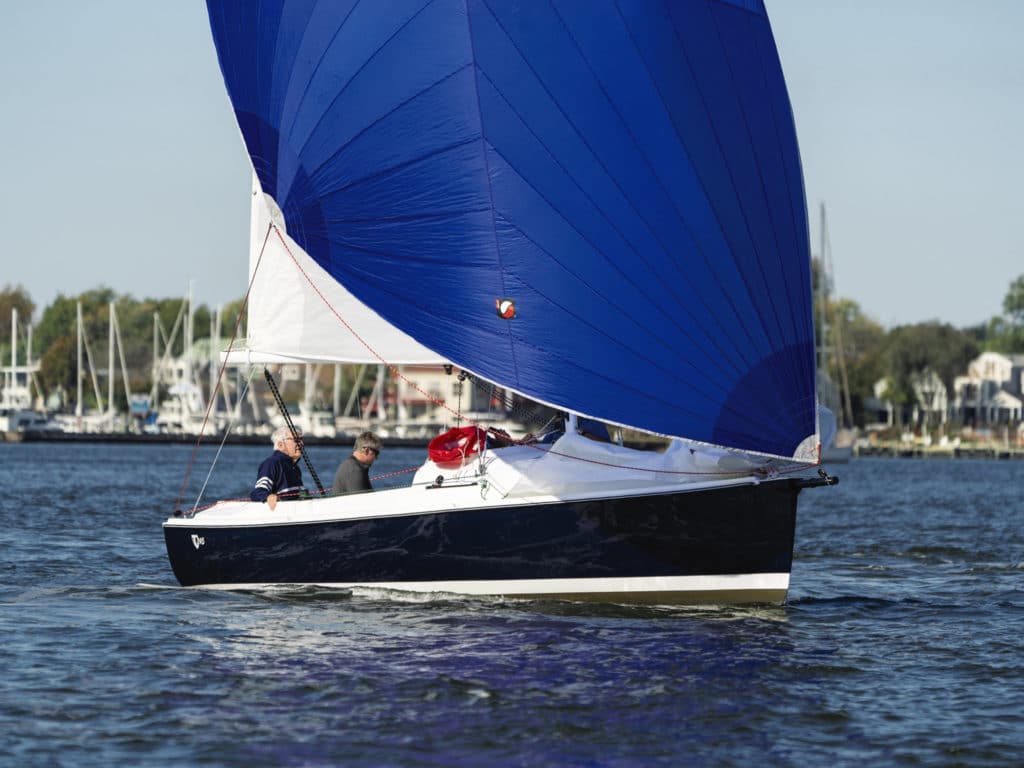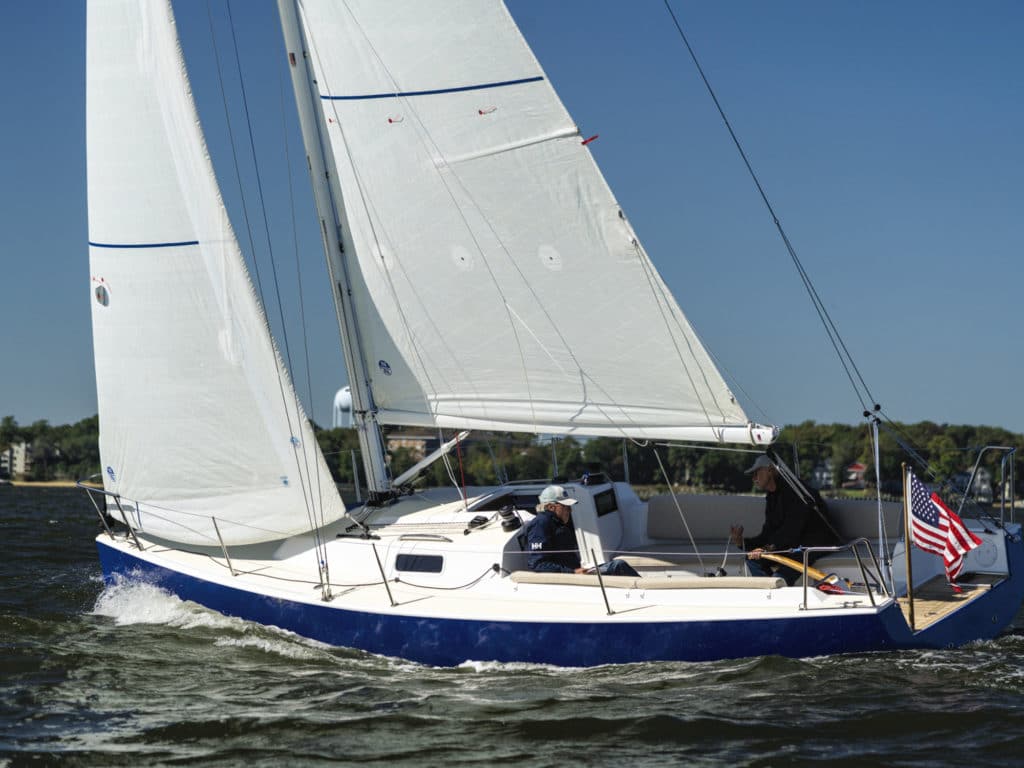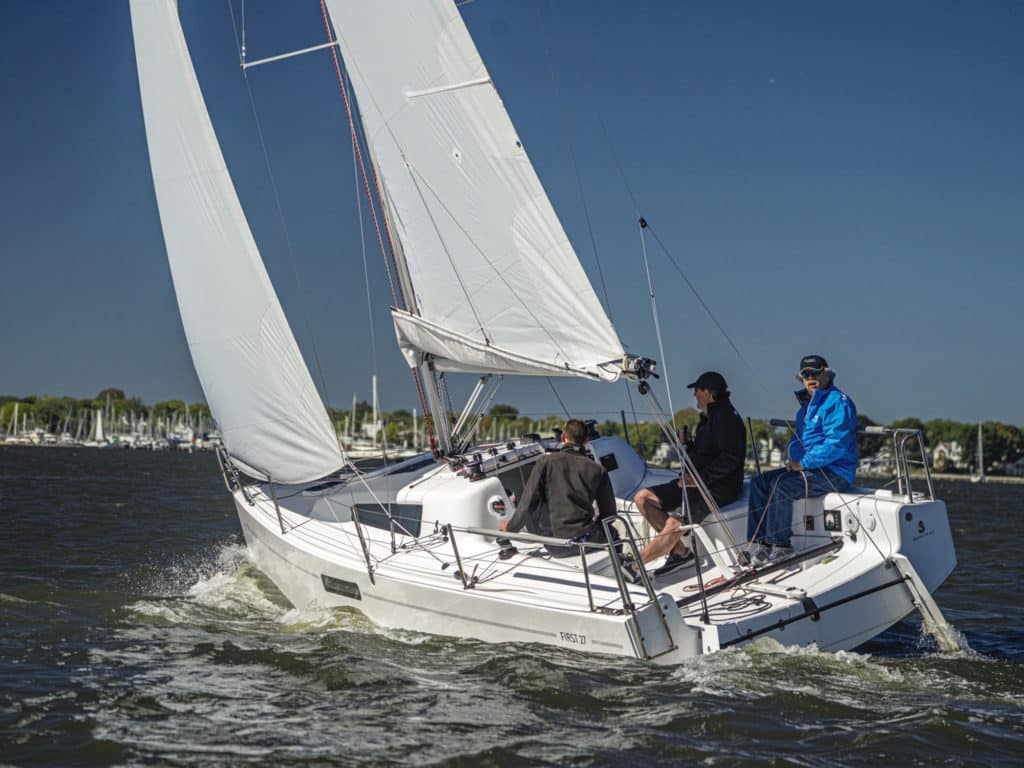
Sailboats are getting bigger all the time. Gone are the days when a boatbuilder like Catalina would pump out hundreds of Catalina 22s in a production run that would last decades. Profit margins for builders are far greater with larger vessels, and more and more buyers—even first-time buyers who’ve never owned a yacht—are coming into the market searching for boats 40 feet or greater. It’s kind of amazing but also true.
That’s why it’s interesting and exciting when production boats under 30 feet debut, and it’s even better when our Boat of the Year judging panel has a dedicated class of nifty new offerings to inspect, as we did for model year 2022.
What’s cool about the trio of boats that comprised this year’s Pocket Cruiser/Daysailer division—the Tartan 245,
J/Boats 28-foot J/9 and Beneteau First 27—is that each was fundamentally different than the others, designed with a specific purpose or sailor in mind. Our task as judges was to determine which boat best served its stated purpose. As a big bonus, all three boats were stout performers and a blast to sail.
With no further ado, let’s have a look at them.
Tough Little Tartan
My first thought when I peered into the cockpit of the 24-foot, Tim Jackett-designed Tartan 245 was that it reminded me very much of my ancient Pearson Ensign, which debuted in the early 1960s. Like the Ensign, the 245 is an unabashed daysailer with a long, inviting cockpit; good stowage beneath the cockpit’s coaming; and a little cuddy cabin forward for stashing sails and duffels, and for a simple berth or head while camping-cruising. When I mentioned this to Cai Svendsen, who’d commissioned the design for use as a trainer in the Judd Goldman Center’s adaptive sailing program, he expressed his fondness for the Ensign and confirmed that he’d incorporated some of its features in the brief.
But the 245 is also quite different than the old Pearson in several important ways. First, it employs a lifting keel with 900 pounds of ballast—a significant number in a vessel that displaces less than 3,000 pounds. Draft with the board down is 4 feet, 6 inches; raised, it’s a mere 1 foot, 8 inches. With a kick-up rudder, this boat can traverse very skinny water and even nudge right up to the beach.
Next, with his experience teaching sailing (novices are known to whack the occasional dock), Svendsen opted for a false, sacrificial bow that is bolted on. It can be quickly and easily swapped out if damaged (you can also spec the boat without what Tartan calls the “Crunchbow”).
Finally, like its larger siblings in the Tartan clan, the boat comes with a carbon rig (deck-stepped on the 245, with swept-back spreaders). You can also order an optional retractable carbon bowsprit for off-wind kites or reachers. For motoring in and out of the marina, there’s a 4 hp outboard. The whole package can be easily towed by a small pickup or SUV.
The profile is no-nonsense with just a hint of a sheerline, and with an open transom for safe and easy swimming (something I wish they’d thought of on my Ensign). Sail controls are atop the coachroof, and the cockpit is definitely roomy; it is meant to accommodate four students and an instructor standing aft. Available sail plans include a choice of overlapping headsails or a self-tacking jib. The whole idea is to make the boat simple and accessible, a fact underscored by its potential use in programs where a wheelchair can be rolled aboard.
Svendsen was gracious enough to take us for an afternoon spin on Chesapeake Bay in a fitful breeze that never topped 10 knots. It mattered not a whit. The tiller-steered 245, with a simple tiller extension so you perch up on the rail with a grand view, was an absolute blast to sail, quite responsive, and surprisingly quick considering its diminutive stature. (The 245 shares this prowess with the many Jackett designs in the Tartan lineup.)
When we sailed right up to the dock and dropped the main, Svendsen left us with this accurate thought: “Little boats are where you have fun. Big boats are where you spend money.”
He’s totally correct. With the Tartan 245, in the fun/cash quotient, the return on investment can be measured in miles and smiles.
| LOA | 24′ |
|---|---|
| LWL | 22’2″ |
| Beam | 8’5″ |
| Draft keel up | 1’8″ |
| Draft keel down | 4’6″ |
| Displ. | 2,750 lb. |
| Sail area | 272 sq. ft. |
| D/L | 124 |
| SA/D | 21 |
- $50,000
- tartanyachts.com
- 440-392-2628
Make My J

Everyone can agree on how awful the pandemic has been, but for fans of the sweet sailing line of J/Boats—designed and marketed by the Johnstone family for some 45 years now—the COVID-19 cloud had a silver lining. It was at least partially responsible for the creation of the company’s latest model: the simple 28-foot daysailer dubbed the J/9.
Company president Jeff Johnstone said that the inspiration for the J/9 came when the regatta season was canceled and he spent time sailing exclusively with his family on a 23-foot J/70, the only boat that was available.
“It was the best summer,” he says. “No racing, just pleasure sailing. I rediscovered my joy for it. We got to the fall and started thinking about older sailors, this whole generation of baby boomers who might be getting out of racing but still want to sail. And we revisited the concept behind the J/100, a 33-footer that was ideal for a simple day’s sail.”
The seed was planted; simplicity would reign.
As Johnstone says, all
J/Boats perform well under main alone. Having owned both a J/24 and a J/30, I can attest that the statement is without hyperbole. At first, the idea was to perhaps go with a boat driven solely by a mainsail. “But it didn’t take long before our sailing instincts kicked in and we wanted to go upwind,” Johnstone says.
So the boat became a straightforward sloop with a furling jib. Hoist the main, unroll the headsail, and away you go. (A short, fixed sprit is available for those who must also fly a spinnaker.)
As with the Tartan 245, the focal point of the J/9 is the cockpit, and it’s clear the team spent a lot of time considering it. (That said, the J’s interior is actually quite cozy, with a pair of settees and an optional V-berth forward; I could have a fun time aboard on a little camping-cruising vacation.) Johnstone said that his team was enamored with and inspired by the Carl Schumacher-designed Alerion Express 28, a fine little sailboat, but the Johnstones made what I consider a significant improvement by going with an open transom that airs out things aesthetically and makes practical sense as a perfect swimming/boarding platform.
RELATED: 2022 Boat of the Year: Best Pocket Cruiser/Daysailer
The boat has a trio of auxiliary options: a basic outboard, an inboard diesel, or an electric Torqeedo Cruise 4.0 pod drive with a dual-blade folding prop that’s powered by a 48-volt, 5 kW lithium-ion battery with a 650-watt charger that can be plugged directly into dockside shore power. “It’s the first time in our history that we could offer an electric alternative at the same price as the diesel, not 20 percent more,” Johnstone says. “And talk about a simple installation.”
We sailed the J/9 on a cracking fall day on Chesapeake Bay in an ideal 10 to 12 knots, and man, it did not disappoint. As advertised, the layout is simplicity personified: one hand on the tiller, the other on the mainsheet. There’s no traveler, but the boom is controlled by an ingenious bridle setup. There’s a clear view of the B&G plotter on the coachroof, the solid Sparcraft vang aids in boom control, and lazy jacks for the main keep everything manageable. And the J/9 sails like a witch, notching just shy of 7 knots hard on the breeze, and topping that number cracked off on a reach.
The joy of sailing, eh? Here’s your ticket.
| LOA | 28′ |
|---|---|
| LWL | 25’4″ |
| Beam | 8’6″ |
| Draft | 4’9″ |
| Displ. | 4,250 lb. |
| Sail area | 272 sq. ft. |
| D/L | 116 |
| SA/D | 27.4 |
- $150,000
- jboats.com
- 401-846-8410
First Is First
When all was said and done, the winning entry in the Pocket Cruiser/Daysailer class was the Beneteau First 27.
It was a tough call because the three boats were so apart from one another—not apples and oranges, but an apple, an orange and a pear. Yet the judges were unanimous in our choice, partly because of the Beneteau’s excellent fit-and-finish, and also because we felt it best-suited for what it set out to do.

“The mission for this boat is shorthanded distance racing, and I think that’s really interesting. It’s probably the fastest-growing segment in the racing scene,” judge Tim Murphy says. “The idea is getting sailors in a competitive environment to really develop themselves as sailors. When racing, it’s not about comfort; it’s all about the sailor getting offshore and navigating and sailing overnight, and having the sail controls and layout set up to derive and maximize the power available in the boat, which is significant. It’s a tool for really becoming an experienced sailor. I think that mission is really strong.”
To underscore that point, our test sail aboard the First 27 was sensational, conducted in 10 to 14 knots of fine Chesapeake Bay wind, with speeds topping out at almost 8 knots hard on the breeze. We did 10 knots with the asymmetric kite up and drawing—it’s set off a retractable sprit—on a tight, close reach. The little rocket is a ball to steer, with a full-width traveler to dump the main in the gusts, and twin outboard rudders that really grip the seaway and offer pinpoint control. Remember, we’re talking about a boat shorter than 27 feet here. It provides the sort of performance usually reserved for craft with significantly longer waterlines.
However, make no mistake—the First 27 is by no means a stripped-out, Spartan racing machine (well, at least the version we sailed; there are two models: one a dedicated racer and the racer/cruiser we tested). All the elements are there for real coastal cruising: a serviceable galley, head and berths, and a 15 hp Yanmar diesel. Yes, the boat was conceived for racing, but it’s also a quite adequate pocket cruiser as well. And on top of all that, it’s trailerable.
Built in Slovenia, the boat was originally marketed as the Seascape 27 before Beneteau acquired the company and rebranded the model as the First 27. Construction is top-notch: vacuum infusion with a PVC foam core, a laminate that’s light and strong. Nearly 1,350 pounds of ballast are incorporated in the lead, T-shaped bull keel (fastened to a steel blade), a significant figure in a vessel that displaces less than 4,000 pounds (the sail area/displacement ratio of 97 is not a typo). The idea was to instill super stability in a hull that planes, a concept that might seem diametrically opposed but works well in practice here. There’s even a little crash bulkhead forward. And all the related equipment is terrific: Seldén spars, Harken winches, B&G instruments and a Spinlock tiller extension, to name a few.
There’s no question that this is an athletic boat to sail and operate, and plenty of adjustments in the rig and sail plan make it eminently tweakable. In other words, there’s nothing sedate about the boat underway. But the effort put in is returned with thrills in spades. For a certain brand of sailor, the trade-off and rewards will be more than worth the sweat equity involved.
| LOA | 26’3″ |
|---|---|
| LWL | 24’5″ |
| Beam | 8’4″ |
| Draft | 5’7″ |
| Displ. | 3,747 lb. |
| Sail area | 401 sq. ft. |
| D/L | 97 |
| SA/D | 25’9” |
- $140,000
- beneteau.com
- 401-990-0270
Herb McCormick is a CW editor-at-large.








